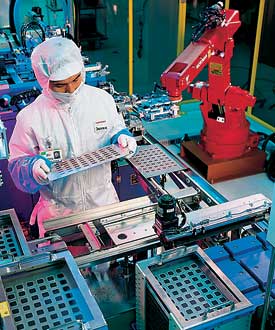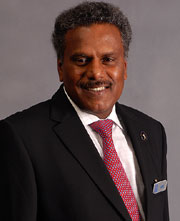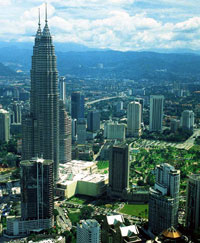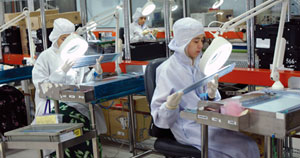



nvestment in key industrial sectors in Malaysia remained robust in 2007. In the manufacturing and services sectors, investments worth US$39 billion were approved by the Malaysian Industrial Development Authority (MIDA) in 2007, up from $32 billion in 2006. The 2007 figure far exceeds the annual target of $23 billion set in the government’s Third Industrial Master Plan (IMP3) for these sectors. Projects approved in both sectors are forecast to create more than 147,000 jobs. Manufacturing projects accounted for $18.8 billion of that investment, with foreign investments behind more than half that amount.
“The increased investments in the manufacturing sector were mainly due to capital-intensive projects, particularly in the electronics and electrical industry, petroleum products including petrochemicals, basic metal projects and paper, printing and publishing,” says a MIDA report issued in February 2008. Noting a wide range of high-end occupations that the projects will demand, MIDA observes, “These projects will contribute to the overall development of human resources in the country.”
That development is well illustrated in the semiconductor industry, which has had a presence in Malaysia since the early 1970s.
Freescale Semiconductor Inc. operates in 30 countries globally and employs 23,000 people. But “Malaysia is Freescale’s largest final manufacturing site for assembly and testing in the world,” says Mr. C. B. Soon, managing director of Freescale Semiconductor Malaysia Sdn. Bhd., which employs more than 4,000, or 17 percent of the company’s payroll. Freescale has invested $1.25 billion in its Malaysia facility so far.
More investment in the sector is even more likely now that the nation’s 2008 budget is in place. It includes two components of particular interest – a corporate tax reduction to 25 percent in 2009, making Malaysia more cost competitive, and new financial assistance for employees seeking to pursue post-graduate degrees.
Malaysia’s IMP3, with a goal of generating more than $300 billion in revenue by 2010,

provides underlying momentum for growth in the electronics sector by pursuing seven objectives:
• Strengthening and deepening the semiconductor sub-segment;
• Deepening and widening the development of the ICT industry value chain;
• Intensifying R&D and design activities;
• Promoting the application of new and emerging technologies;
• Integrating the industry into regional and global supply chain networks;
• Making available a sufficient supply of highly skilled and innovative workers; and
• Strengthening institutional support.
Dell Asia Pacific is no less enthusiastic about its Malaysian operations; its Asia Pacific Customer Centre 2 in Penang, which opened in 2001, is five times the size of Dell’s pre-existing factory in Malaysia and has twice the capacity. It can produce two million notebook computers, PCs and servers annually.
“This new factory is indicative of Dell’s confidence in Malaysia and the region,” says Simon Wong, vice president of Dell’s Penang operation. “We are unfazed by the slowdown in the U.S. economy, and we are confident in our Asia-Pacific operations and anticipate greater growth in the region.”
What is behind this confidence?
“Dell chose to base our integrated facilities here because of Malaysia’s strategic location in the Asia Pacific – the way our facilities in Xiamen, China; Austin, Texas; and Limerick, Ireland, serve greater China, the Americas and Europe respectively,” Wong explains. “Malaysia is also supported by an established infrastructure and highly trained work force from which we draw the people who carry out our direct business model.
“Malaysia’s commitment to creating a knowledge economy will be driven by innovation, entrepreneurship and technology,” he adds. “Dell supports this and will do its part in participating in this vision fully.”
Site Selection Online – The magazine of Corporate Real Estate Strategy and Area Economic Development.
©2008 Conway Data, Inc. All rights reserved. SiteNet data is from many sources and not warranted to be accurate or current.



